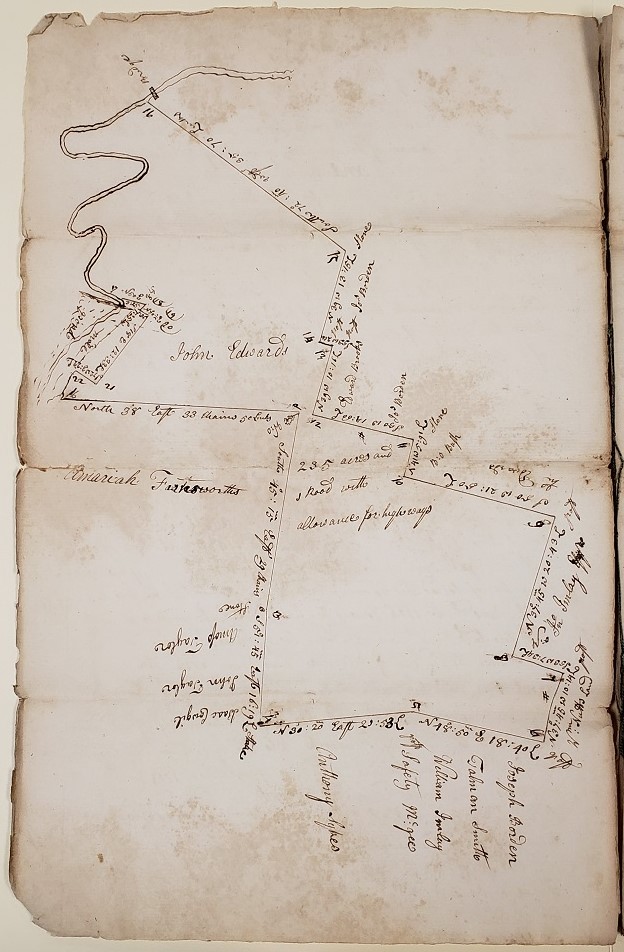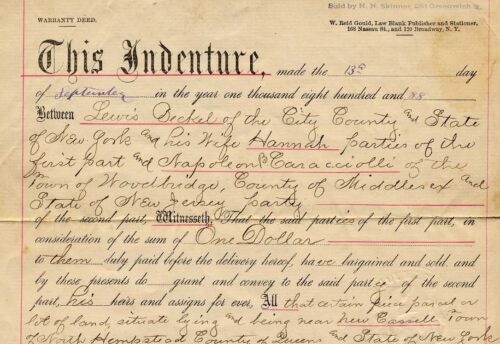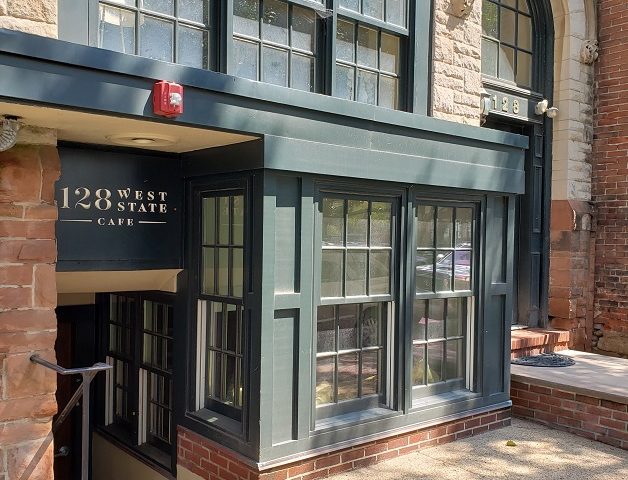INTRODUCTION
If you have ever searched through old deeds while investigating the origins of a house’s history or to discover where your ancestor lived, you may have run into a dead end while searching through the deeds. There are multiple reasons why this occurs, anywhere from the property being conveyed through probate of an estate, the property being sold at auction, or being confiscated during the War for Independence. Whatever the reason, the solution may be found by searching through a series of other resources. Each situation is different and requires a unique approach. This short article will provide some suggestions that may open the door to solving your deed search brick wall.
GETTING STARTED
When the chain of owners breaks within the line of deeds, there may not necessarily be one resource providing the answer of who owned the property prior. Before you begin, as you search further back in time, it may be helpful to search the name of the road under the topic ‘road name changes’ in the town you are focused on to see if the road name was different during the years you are searching. Also, consider that though the location of the house may not have changed, the number may have changed as the area developed. One last thing to keep in mind is that a house located in a city is easier to trace back in time than one in a rural area simply due to the fact that more resources are available for city buildings.
There are several facts that are helpful to draw from the last deed found including the date it was executed, the date it was recorded, the names of the grantor (seller) and grantee (buyer), the town, county, and state where the property is located, and the surveyed directions (or detailed description) of the property, which is usually noted in a listing of metes and bounds. Within the directions, you may find the names of neighboring land owners. These can be essential in finding the answer in some cases. Also take note if the deed mentions a mortgage.
USING SURROUNDING NEIGHBORS

Names of neighboring property owners noted on a deed can be quite helpful, though time consuming. Searching for the deed for that neighbor’s purchase may supply the name of the owner who owned the property you are searching prior to the last owner you are aware of . Typically there are several neighboring properties and several chances to find the answer you are looking for.
For example, below is the directions for a property in 1818 New Jersey:
- Beginning on the south westerly corner of Richard Stockton Esquire‘s lot, on the east side of Main Street in Bordentown aforesaid and running with said Stockton’s lot north sixty five degree east to Richard Herbert‘s lot
- Thence with said Herbert’s lot south twenty five degrees east sixty five feet to a stone for a corner
- Thence south sixty five degrees west with Joseph Hopkinson‘s lot thirteen perches and one third of a perch to Main Street
- Then with Main Street sixty five feet to the place of beginning.
As you can see, there are three neighbors listed. They are either living on, or own, the neighboring property. Suspecting that they owned the property in 1822 means they purchased their land prior to that year. Searching their name in the index under grantee pre-1822, may list the neighboring owners in the deed directions of their property, which would include the one you are researching. At the point that you pull up their deed, read the directions of their property and at least one side should match one side of your property and will note who owned it at the time. This of course is idyllic. However, the name listed may be the person residing on rented property, or may be the same name of the person on the 1822 deed. In that case you may need to search the neighbor’s property back further which may list previous owners of your property. In addition to deeds, searching mortgages in a similar manner may be helpful since at times it will also list the property directions and list neighbors.
USING THE ADDRESS
Using the address of the property can be helpful. However, the address was not always available in the earlier years. For instance, census records can be searched using an address between the years 1880 and 1950. Prior to that, only the ward, town, county and state were noted on census records. While it is possible to locate the address using earlier deeds, that is more complicated. For earlier years, city directories can be searched for some locations. For example, New York City’s 1789 directory included house numbers and street names. Once again, it should be remembered that the numbers likely changed, and street names also changed at times, as the city developed. Searching newspapers using the address can also provide the owner’s name. While it is not common to include a person’s address in newspaper articles today, it was in the past. For example, addresses were often included for house weddings, events held at a person’s home, for funeral viewings, which were generally held at the deceased’s family home. Even articles about an accident would often list the address of each person involved.
MAPS
Land Ownership maps are the most helpful and typically can be found for 1850 and sometimes earlier depending on the location. For instance, if there is a break in the deed chain in 1875 where you cannot find the name of the previous owner, an 1850 map may show the owner prior to 1875. If it is the owner that is noted on the map, you can then search the deeds using their name to discover if there is a connection to the last owner you are aware of. For instance, if Bob Smith owned the property in 1850, but Mary Green owned it in 1875, with no apparent conveyance of the property between the two, a search in the deeds for Bob Smith conveying the land can be helpful. A detailed search of Bob Smith may reveal the answer. He may have obtained it through a sheriff sale at auction or through probate from a family member or friend. However, once again, keep in mind the person listed on the map may have leased the property from the owner. Maps can be found at loc.gov, local universities, state archives, and historical societies. County clerk’s offices sometimes retain maps such as tax maps and other historical maps, but that varies from county to county. The county Surrogate’s Office typically have maps connected to estates.

PROBATE & ORPHAN’S COURT/DIVISION OF LANDS
At times, the conveyance of property was recorded in the Will of the deceased or during the division of property among the heirs in a resource known as the ‘Orphan’s Court.’ If the resource is not a familiar one, it may be overlooked. The division of property can also be listed in the Division of Lands book, and at times listed in both. As an example, when searching the history of a home in New Jersey, I came across a deed which did not provide the name of the previous owner. I looked up the name of the owner in the deed index under grantee and found that there was no deed listing for her having purchased the land. The natural next consideration is that she obtained it from a family member, likely a parent through probate. Though I did find that her father had heired property to her, that didn’t mean that it was the same property I was researching. I discovered who her father was and found a probate record. In her father’s Will, he requested that his property be divided equally between his two daughters. I was only interested in discovering whether this was how the previous owner obtained the land and whether her father was the previous owner of this particular property. The details of the property division were listed in the February 1795 term of the Orphan’s Court record and April 1795 in the Division of Lands book. Though the property I was researching was much smaller than that noted in the records, I was able to use some of the property directions to match the property I was researching, confirming that the owner’s father had been the previous owner. From there, I was able to continue the chain back further from the father. Aside from searching probate of the last known owner, it may also be helpful in some instances to search probate records for surrounding neighbors to see if a map is included that names neighboring owners.
Though I have named a few resources and ways of how to work through some brick-walls when it comes to deed chains, I expect that these are not the only solutions or resources that may help. Please feel free to share how you broke through a deed chain brick-wall.

